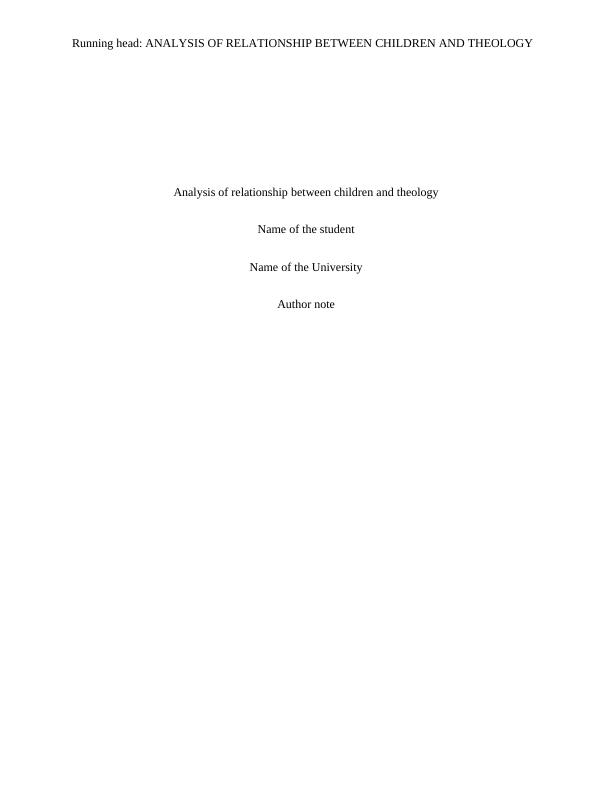Ask a question from expert
Children and Theology - Doc
6 Pages1361 Words371 Views
Added on 2021-04-17
Children and Theology - Doc
Added on 2021-04-17
BookmarkShareRelated Documents
Running head: ANALYSIS OF RELATIONSHIP BETWEEN CHILDREN AND THEOLOGYAnalysis of relationship between children and theologyName of the studentName of the UniversityAuthor note

1ANALYSIS OF RELATIONSHIP BETWEEN CHILDREN AND THEOLOGYIntroductionChildren and theology are correlated. Theology plays an integral role in a child’s life andundoubtedly has a great impact on children in building their character (Conroy et al. 2013).Often children want explanations of religious incidents, which in turn encourage children toknow more. To be very specific, as per Stern (2018), they develop a quest of knowledge withinthemselves. According to (Davis and Miroshnikova 2013), theology helps a child to understandwhat a child wants to know and according it helps in structuring the curriculum of learning sothat he or she can get the answers regarding theology. However, it has been observed thatmostly, children do not remember theological stories and tend to avoid reading them as they findit boring.DiscussionJerome W. Berryman in his essay (Berryman) discussed that children often ask forexplanation of religious events or incidents, which means that children think deeply abouttheology more deeply than adults do. However, teachers as well their elders find difficult toanswer these questions. The author points out that in order to address the issue, parents, orteachers can talk about theodicy in an appropriate manner. Therefore, a brief overview oftheodicy is given in the essay. In addition to that, some tools were discussed in order to limit thecognitive development of children. While briefly discussing about theodicy and the mechanismto control the cognitive development, primary dangers were also discussed. The issues anddangers of early childhood, middle childhood and late childhood were identified and examined.The author says in the conclusion that answering and explanation of the existence of evil spirits

2ANALYSIS OF RELATIONSHIP BETWEEN CHILDREN AND THEOLOGYdo not only enable children to understand the concept of evil but it also helps in the growth ofcognitive thinking (Hull 2017). Rather theodicy, which is the explanation of why god has createdevil, makes children able to think theologically. According to the author, children must beallowed to think independently and develop their understanding of theology accordingly. Parentsor teachers therefore need to interact with children regarding presence of God and Evil so thatchild can be able to understand what is evil and deal with it while moving towards earlyadulthood.Berryman’s next article discussed about the power of laughter in religious education(Berryman 1998). In this study, the author had analyzed the history regarding laughter and itsconnection with freedom. For further discussion onto the topic, four models of laughter havebeen defined and then examined. In the next part of the discussion, the author elaborated thefeeling while emerging out of the chaos that exists in human being. In addition to that, it alsodescribes the type of laughter that emerges out the experience. In the final part of the discussion,intrinsic motivation and its re-exploration have been described along with the implication thatmay help in teaching as well as learning religious education. The article mainly highlights therole of laughter in religious education for children and the author suggested that teachers ofreligious education must be aware of the role of laughter in order to make their teachingeffective. In order to examine the connection between laughter and motivation for the purpose ofreligious education four models of laughter have been briefly described. The models that arediscussed are the philosophical models of laughter: Superiority model, Incongruity model, Reliefmodel and Pleasant Psychological Shift model. After analyzing the history of laughter and fourmodels, the author makes two observations. The author sates that extrinsic behavior has both thepositive as well as negative impact on the shaping of behavior of child. According to the author’s

End of preview
Want to access all the pages? Upload your documents or become a member.
Related Documents
Designing early childhood curriculam PDFlg...
|7
|1598
|72
Report on Technology Effect in Child Developmentlg...
|8
|1578
|235
ECE100 | Child Growth and Developmentlg...
|11
|2331
|14